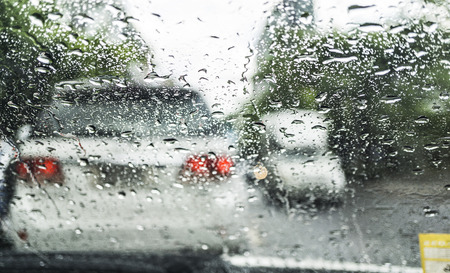8 Tips for Driving When Sudden Wet Weather Occurs
September 26, 2016 | Category: Automobile Accidents, Motorcycle Accidents, Personal Injury, Truck Accidents | Share The Florida Department of Transportation reports that nearly 1.2 million traffic crashes each year are weather related. The vast majority of these crashes happen during rainfall as the result of wet pavement caused by thunderstorms.
The Florida Department of Transportation reports that nearly 1.2 million traffic crashes each year are weather related. The vast majority of these crashes happen during rainfall as the result of wet pavement caused by thunderstorms.
What type of thunderstorm does Florida receive?
The Florida Climate Center at FSU (Florida State University) classifies thunderstorms as:
- Ordinary Cell: As the name implies, this is a thunderstorm with only one cell. It is commonly referred to a ‘pulse’ thunderstorm.
- Multi-cell Cluster: These are thunderstorms that are organized in clusters of 2-4 short-lived cells.
- Multi-cell Line: Some thunderstorms will form in a line which can extend laterally for hundreds of miles. These 'squall lines' can persist for hours. Squall lines can be continuous or have breaks and include contiguous precipitation. Long-lived squall lines are known as "derechos" and can travel hundreds of miles, causing considerable damage along their path.
- Super-cell Thunderstorms: These are potentially the most dangerous form of all thunderstorm types. Super-cell thunderstorms have produced numerous long-lived strong and violent (EF2-EF5) tornadoes, along with damaging wind, hail and flash floods.
Rain impacts roadways and increases the chance of an accident in the following ways, according to the Federal Highway Administration:
- Limits visibility;
- Effects pavement friction (slippery roadways, hydroplaning);
- Creates lane obstruction (such as large puddles and potholes created by excessive rain);
- Creates variable traffic speeds; and
- Causes aggressive driving and failure to adapt to road conditions.
Although weather forecasters often report on the potential of rainfall, when driving, drivers do not always anticipate, or are prepared for, the sudden occurrence of high winds and torrential downpours.
The way one drives can obviously have a significant impact on wet-weather safety. Drivers need to be attentive to the situation around them, including what other drivers are doing and how they are reacting to conditions. Here are 8 tips from MobilOil.com to decrease the chances of accidents in wet weather:
- Slow down early, before you encounter a problem, and be aware that you have fewer grips available from your tires for stopping, steering and accelerating. Remember: Even four-wheel drive and anti-lock brakes cannot change the laws of physics.
- Even a new tire can begin to hydroplane on wet surfaces, so watch your speed. If the steering begins to feel light, and the car is splashing through deep puddles, gently reduce your throttle to allow the car to slow to a more manageable speed. Do not lift the throttle abruptly or hit the brakes, since this could unsettle the tires’ grip on the wet surface.
- Never drive your car through deep water on a flooded road. You simply cannot tell how deep the water is. It does not take much water to disable your vehicle or even float it off of the road surface. If you have any doubt about water depth, stop and go back the way you came. If you must drive through deep puddles, gently press the brake pedal one or two times afterward to help dry the brakes before you need to use them to stop the car.
- Use the various speeds on your windshield wipers to help remove the amount of water that is hitting the windshield. This sounds simple, but some people forget that at higher road speeds you need the highest wiper speed.
- Be aware of the spray coming from passing trucks and oncoming cars. It may blind you temporarily, so anticipate this by turning on or increasing the speed of your wipers and by looking at what is happening to cars ahead of you.
- If it begins to rain very lightly after a long dry spell, the water will mix with the oils on the road to produce a very slippery surface. Treat these conditions with great caution since even new tires will not give much grip on this oil-and-water mixture.
- Turn down the radio and turn off your cell phone. Driving in heavy rain demands much more of your attention than driving on dry roads.
- If conditions become too intense, pull far off the road in a safe place to wait out the storm. If your car becomes disabled, pull as far off the road as possible, turn on your four-way flashers and call for help. Stay in your car.
“Driving in any weather requires full attention and anticipation of situations which may occur. Should you or a loved one be injured in an accident as the result of another’s failure to drive in a safe manner, please contact our experienced team of attorneys to assist you. There are no costs or attorney’s fees until you win,” said Fort Myers Auto Accident Attorney, Randall Spivey of Spivey Law Firm, Personal Injury Attorneys, P.A.
Fort Myers Auto Accident Attorney, Randall L. Spivey is a Board Certified Trial Attorney – the highest recognition for competence bestowed by the Florida Bar and a distinction earned by just one (1%) percent of Florida attorneys. He has handled over 2,000 personal injury and wrongful death cases throughout Florida. For a free and confidential consultation to discuss your legal rights, contact the Spivey Law Firm, Personal Injury Attorneys, P.A., in Lee County at 239.337.7483 or toll free at 1.888.477.4839,or by email to Randall@SpiveyLaw.com. Visit SpiveyLaw.com for more information. You can contact Spivey Law Firm, Personal Injury Attorneys, P.A.in Charlotte County at 941.764.7748 and in Collier County 239.793.7748.

